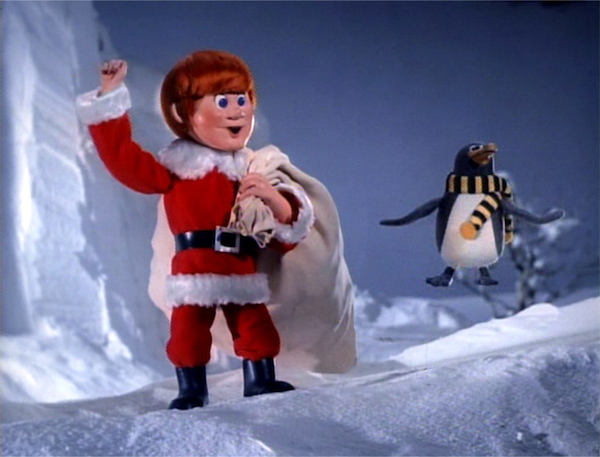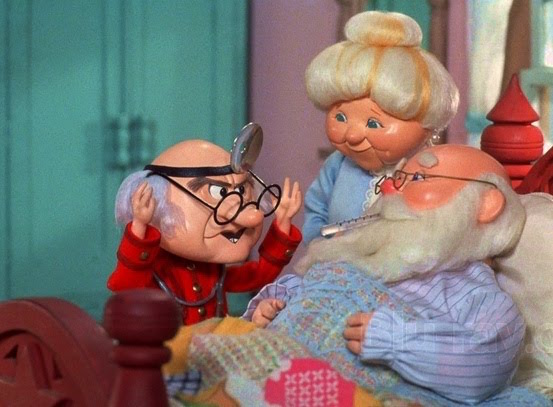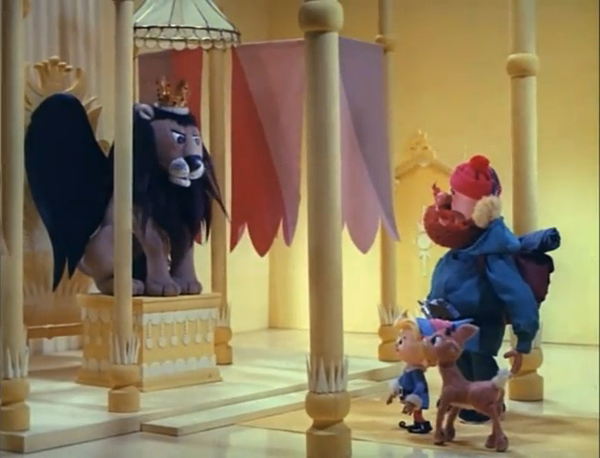
BY MAX BURBANK | Like many modern American Jews, I learned everything I know about Christmas straight from what seemed to be the most reliable source available: Rankin/Bass. Jesus aside (a footnote at best, having a non-speaking role in only one Rankin/Bass Special, the critically panned late-Animagic-era “Little Drummer Boy”), Christmas revolves around worship of the life and deeds of the man/god Santa.
What do we know of this “Jolly Old Elf?” Is he a reliable vessel for our Children’s faith? What are his labor practices? If he and the Christ Child had a no-rules tables, chairs, and ladders cage match versus Superman and the Tooth Fairy, who would win?
To come to a better understanding of Santa, I have decided to examine the Rankin/Bass Christmas works — not in the order they were created, but in the chronological order of their storylines. For purposes of this article, no reference will be made to the “crossover” work of the late “decadent period,” where Santa is, at best, peripheral (see the execrable “Rudolph’s Shiny New Year”).
SANTA CLAUS IS COMIN’ TO TOWN (1970) | Here we learn the root of Santa’s multiple issues: his abandonment as an infant. Raised by a foster family of Elves, he will suffer complex questions of identity throughout his life (see Cher, “Half-Breed”).
In this light, the compulsive rejection of the rule of law (see “Burgermeister Meisterburger”) which lands him in jail is no surprise. Rather than serve his time and allow the possibility of rehabilitation, he instead turns to the Dark Arts (see “Winter Warlock”). A brief nod is given to Judeo-Christian Ethic when the Warlock loses his powers because he has become “good.” But by the end of the hour, his abilities have inexplicably returned. Santa, having dragged a local schoolteacher into his delusions of grandeur (see Sissy Spacek, “Badlands”), convinces her that he can see children at all times, and must judge them as “naughty” or “nice.”

With his common-law bride, Elf gang and geographically misplaced penguin sidekick (see “Bonnie and Clyde”), Santa goes on the lam — fleeing, quite literally, to the ends of the earth. Only the Burgermeister’s death avoids a Waco-like siege at the North Pole. Over time, Santa’s cult of personality calcifies into a less reactionary, quasi-legitimate religion, which is certainly nicer for the Elves than the vat of grape Kool-Aid Mrs. Claus was almost certainly mixing up.
Santa’s near-pathological orphan’s need to establish a firm societal role (see “Batman”) is at last fulfilled when Mrs. Claus suggests restricting his serial breaking and entering to a single night each year: Christmas Eve, the “Holiest night of the year.”
THE YEAR WITHOUT A SANTA CLAUS (1974) | Santa, in the grip of psychosomatic illness, cancels Christmas. Having achieved psychological domination of the world’s children, he now abandons them, symbolically becoming his own Parents on a scale befitting his megalomania (see Harry Chapin, “Cat’s In The Cradle”). His actions constitute a passive-aggressive punishment on all children for failure to “believe” in him.

Only when fealty is established (as demonstrated by the bestowing of gifts upon Santa by what appear to be the animatronic robots from the “It’s a Small World” ride) can Christmas take place. Santa’s usurpation of the religious nature of the holiday (the concept that he has the authority to “cancel” the celebration of Christ’s Birth) is now complete. This episode’s overall darkness of tone (see “The Empire Strikes Back”) is mitigated slightly by the show-stopping and surprisingly inclusive “Heat Miser” and “Snow Miser” numbers.
RUDOLPH THE RED-NOSED REINDEER (1964) | Santa’s power has begun the long, inescapable decline of all revolutions, a process graphically symbolized by his rapidly fluctuating weight — a sure indicator of Body Dysmorphic Disorder (see any movie featuring Eddie Murphy in an offensive fat suit).
Abandoning the ideology of his youth, he becomes a primarily secular authority. Crabby, irritable, old, and above all, thin, he drifts easily to the role of supporting character. Voiced twice as a younger man by Mickey Rooney, the role is now taken up by Stan Francis — a virtual unknown whose vocal identity is further diluted by his double casting as the hybrid tyrant, King Moonracer.

Santa’s management style can be seen in the brutal sweatshop mentality of the Toy Shop — which values only conformity, and is unable to embrace the diversity embodied in Hermey, an openly gay Elf. His social values are reflected in the neo-Teutonic “Reindeer Games,” forbidden to Rudolph (see “Schindler’s List”), whom Santa only accepts into the fold once a way to exploit his unique abilities has been discovered (see “X-Men”).
Santa is again seen as willing, perhaps even eager, to “cancel” Christmas. His excuse this time is Weather, demonstrating that either his will or his magic have become weaker than the Oath of the United States Postal Service. Those who see Santa’s inclusion of the “Misfit Toys” as a sign of ethical growth will be dismayed to learn that Rankin/Bass added this scene in 1965 after an intense write-in campaign (see “The Enchanted World of Rankin/Bass” by Rick Goldschmidt — an actual book, and not just another lame “see” joke). The psychological import of Santa hot-rodding around the North Pole on an oversized Norelco electric shaver is really anybody’s guess, but was obviously disturbing enough to be cut from modern broadcasts.
CONCLUDING THOUGHTS | So who is this “Santa” (see “Easily Decipherable Anagram”)? Dominated by abandonment, his entire life is dedicated to being the “good father” to all humanity’s children — but in pursuit of this goal he becomes neurotic, domineering, hypochondriacal, exploitative, and increasingly powerless.
Once immortal and near omnipotent, he is, in the end, distinctly human. I would invite readers to draw their own conclusions, but would at least suggest they exercise caution before allowing their children onto the old man’s lap.

















